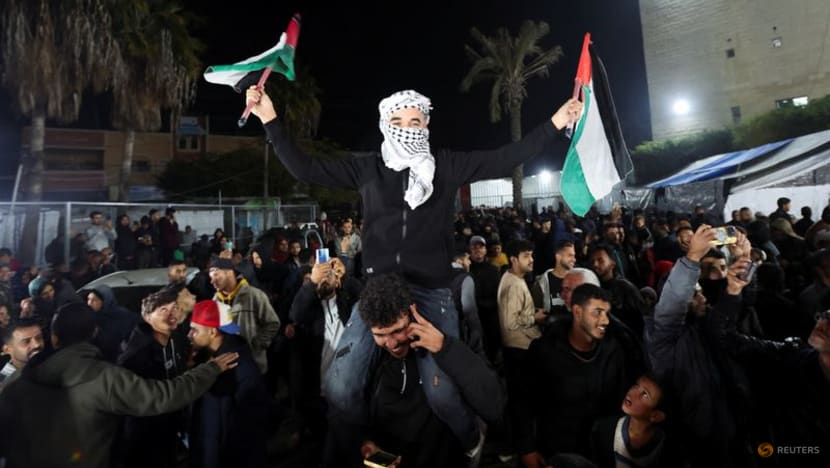Advertisement
The real test will come 16 days after the ceasefire takes hold, when negotiations begin for the second phase that will see a more lasting truce, experts say.

A man waves Palestinian flags as Palestinians react to news on a ceasefire deal with Israel, in Deir Al-Balah in the central Gaza Strip, January 15, 2025. REUTERS/Ramadan Abed
New: You can now listen to articles. 
This audio is generated by an AI tool.

16 Jan 2025 05:09PM
A ceasefire deal that will pause the 15-month war in Gaza and see the exchange of Israeli hostages and Palestinian prisoners is a promising development, but the truce remains fragile and root problems persist, analysts said on Thursday (Jan 16).
Still, they were positive the deal would outlast the only other ceasefire that had been held so far – for a single week in November 2023 – citing war fatigue and depleted ranks.
“I’m a little more optimistic than I would have been months ago, and that’s partly because both sides have also expended a lot of capability by now,” said Jessica Genauer, a senior international relations lecturer at Flinders University.
“(But the deal) is precarious. It’s fragile. Both sides need to maintain that commitment,” she told CNA938, adding any violations could easily lead to a renewal of hostilities.
PHASES OF THE CEASEFIRE
The real test will come 16 days after the ceasefire takes hold, when negotiations begin for the second phase, analysts said.
In stage one, which comes into effect on Sunday, 33 Israeli hostages – including women, children and the elderly – will be freed in exchange for Palestinian prisoners in Israeli jails.
Israeli forces will start a gradual withdrawal from populated areas in Gaza, and permit humanitarian aid to flow into the territory. Displaced Palestinians will be allowed to begin returning to their homes.
“In this first phase, we’re seeing immediate factors that both sides can agree to more easily without having to dive into more tricky political issues that would lead to a more sustainable settlement,” said Genauer.
The second phase, if reached, will kick in after six weeks and should see the remaining hostages released, a full withdrawal of Israeli forces from Gaza, and a permanent ceasefire.
The third and final stage will involve the return of dead bodies and the reconstruction of Gaza.
FACTORS LEADING TO DEAL
Similar deals have been put on the table over the course of the war but fell through time and again.
Analysts said Israeli Prime Minister Benjamin Netanyahu, who has been accused of prolonging the war for his own political self-preservation, has been under mounting domestic pressures to bring hostages home.
By now, Israel has achieved numerous military objectives, including eliminating several key figures in the Hamas leadership and severely degrading the militant group’s firepower, at least in the immediate term, said experts.
A power transition in the United States is also a major push, with Donald Trump taking over the presidency from Joe Biden next Monday, analysts added.
Israel’s far-right politicians, who were previously critical of proposals from the Biden administration, likely believe in securing Trump’s support for their interests in the future by agreeing to the ceasefire, said Ryan Bohl, a senior Middle East and North Africa analyst at risk advisory RANE Network.
“The Israeli far-right now believes they will be able to trade a ceasefire in Gaza … in exchange for expansion of settlements in the West Bank, which is a core goal for them,” he added.
UNDERLYING ISSUES
One glaring question that has not been addressed in the deal is the governance of Gaza, noted analysts.
Hamas has controlled the enclave since 2017, when it ousted the Palestinian Authority from power.
Israel is vehemently opposed to Hamas having any hand in running the strip and has sought to destroy the militant group.
Bohl said neither side wants to go back to a full-scale conflict, but since there is no formal mechanism in place to monitor the ceasefire, he expects sporadic pockets of violence to erupt every now and then.
“(The Gaza truce) will probably look very similar to what we’re seeing in Lebanon,” he told CNA’s Asia First programme, referring to Israel’s agreement with Lebanese militant group Hezbollah two months ago.
“It hasn’t ended Israeli air strikes on Hezbollah and hasn’t resulted in Hezbollah completely abandoning positions or sticking by the stipulations of their own ceasefire,” he added.
“What we’re seeing (in southern Lebanon today) is an unsteady, semi-frozen conflict, intermittent fighting, and that’s probably what’s going to happen in Gaza, but certainly nothing at the scale of what we’ve seen over the past 15 months.”
He emphasised that Palestinians being disenfranchised is the core cause of Israeli-Palestinian conflicts, and nothing in the agreement seriously suggests that any of the parties are on a path to resolve the root problems.
“Unfortunately, this ceasefire, like many ceasefires in Gaza before, has all the embers of the next war,” he said.
“Without redressing Palestinian political status, either as an independent state or as citizens within a binational state, without some sort of redressment on that front, the next conflict, the next war, is inevitable.”
